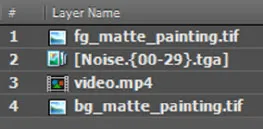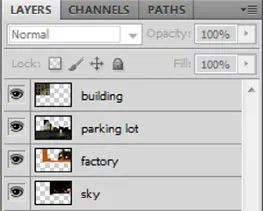Nuke was designed to create digital visual effects on feature films. As such, it carries a robust set of tools that make high-end postproduction available to professional digital artists, independent filmmakers, students, and hobbyists alike. The core of Nuke’s functionality is a system of connected nodes.
Although node manipulation may seem odd to an artist who has mastered layer-based programs, the efficiency and power of nodes comes to light after a basic knowledge is achieved.
This chapter includes the following critical information:
• Overview of interface panes and panels
• Comparison of layer-based and node-based compositing
• Node manipulation, including creation, connection, adjustment, and arrangement
• File importation and output rendering
• Timeline and flipbook playback
By default, Nuke’s main window is divided into three panes: the Viewer pane, the Node Graph/Curve Editor pane, and the Properties Bin/Script Editor pane (Figure 1.1). Any given pane may have more than one tabbed panel. For example, you can switch from the Node Graph panel and Curve Editor panel by clicking the Curve Editor tab. Each pane includes a content menu, as represented by a gray-checkered Content Menu box at the top left of the pane. If you click on the Content Menu box, a pop-up menu opens and displays a set of options you can use to customize the pane.
The menu bar is located on top left of the Nuke window. The bar hosts commonly used dropdown menus, including File, Edit, and Viewer (Figure 1.2).
The toolbar is located on the left side of the Nuke window and contains between 13 and 17 icons, depending on the version of Nuke you are using. The icons represent different categories of nodes such as Image, Draw, and Time (Figure 1.3). You can use the toolbar to add nodes to the Node Graph. To do so, click on an icon and choose a node from the resulting dropdown menu. It’s also possible to add nodes through an RMB shortcut menu in the Node Graph; this is described in the “Using the Node Graph” section later in this chapter.
Adobe After Effects, which is the most widely used compositing package in the world, is layer-based (Figure 1.4). Adobe Photoshop shares a similar layer structure (Figure 1.5).
Nuke, on the other hand, is node-based. A node is a discrete unit used to build linked data structures. On a more basic level, you can think of a node as a box that contains specific information that can be shared with neighboring node boxes. In Nuke, a node is represented by a rectangle icon in the Node Graph (see Figure 1.6 in the next section). The information the node carries is displayed as parameters through its properties panel.
With layer-based compositing, each utilized image sequence, still image, and movie file is placed on a layer. Each layer has its own set transformations and carries an optional set of filters. Layers are stacked and processed in order from bottom to top. This is roughly analogous to a stack of cut-out magazine photos. Higher layers win out over lower layers unless nonstandard blending modes are selected or the higher layers possess transparency. Photoshop PSD files store layer transparency information. Other image formats, such as Targa or TIFF, store transparency through a fourth channel known as alpha.
With node-based compositing, each utilized image sequence, still image, and movie file is represented by a unique node. In Nuke, the Read node fulfills this duty. The output of each Read node is connected to the inputs of other nodes, including various filter nodes and merge nodes. The final result is output to a Viewer node (for display in the program) or a Write node (to write an image sequence to disk).
A Nuke node supports a limited number of inputs. However, you can connect the output of a Nuke node to an unlimited number of nodes. When multiple nodes are connected through their inputs and outputs, the structure is known as a node network, tree graph, process tree, or node graph. In Nuke, the work area that you use to create and edit such node networks is called the Node Graph; the Node Graph can carry multiple networks. More specifically, the node networks are a directed acyclic graph (DAG) where information only flows in one direction for each connection.
There are several advantages to using a node-based compositor:
• You can easily create complex node networks. In contrast, you can only stack layers. With a layer-based system, it’s difficult to connect the output of a single layer to the input of multiple layers; workarounds require the nesting of composites or prerendering certain layers to disk.
• When carefully set up, a node network is easy to interpret. Complex layer-based composites can be difficult to navigate due to the sheer number of layers that are required.
• High-end compositing systems used in the feature animation and visual effects industries are node-based. The systems include Flame, Inferno, Shake, Fusion, and Toxik.
Any given node in Nuke has a set of input and output pipes. A pipe is a connection between nodes that allows the flow of information between nodes. A pipe can only send information in one direction. Before a node is connected to another node, the pipes are broken or are indicated by arrow stubs (Figure 1.6).
More specifically, a pipe carries one or more channels. A channel is a discrete component of a digital image that represents specific information as scalar values (whereby a pixel of a single channel can only carry in single magnitude or intensity); the information may be the distribution of a primary color, such as red, or the distance an object is from the camera, as with a Z-depth channel. Channels commonly used in Nuke ...







